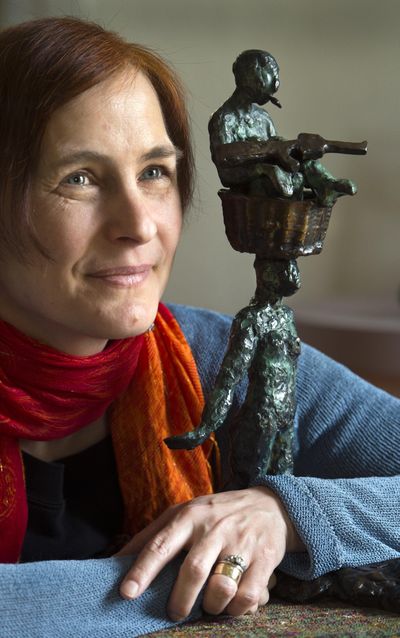Shining the light on refugees: Ildikó Kalapács’ ‘Unwanted Journeys’ features mixed media

Spokane artist Ildikó Kalapács insists that her new show, a mixed-media art exhibition on refugees with participation of refugees, is not “political.” If anyone does try to politicize the issue at her opening tonight night at Object Space, she will not stand for it.
“We will not discuss politics because I am only interested in the human condition and what refugees go through,” Kalapács said. “I am a humanist. I am a visual artist. I have my own politics as a person, but to me, my artworks are only a conduit.
“I am really just throwing ideas out there and I am just not naïve enough to believe I can change anybody’s mind. But I think it is very important to provide a glimpse into (refugees’) experience. That’s all I can do.”
Kalapács’ show, “Unwanted Journeys,” includes the artist’s own sculptures and drawings of refugees as well as poetry and personal narratives by refugees. Kalapács will also show a short video and display photographs she took of refugees now living in the Spokane area who were willing to share their stories. She was able to include the voices of Jackson Leno of South Sudan, Maraam Hamadi from Iraq and Emanuel Kasa from the Congo. It was difficult to find displaced people locally who felt safe enough to record their narratives and reveal their identities, Kalapács said. There are an estimated 65 million refugees worldwide.
Through the efforts of World Relief Spokane and Refugee Connections Spokane, several Spokane-area refugees will be picked up and transported by bus to attend the exhibition’s opening.
“Many of them do not live close to town, so I hope this will be a way for them to meet more people in the community and each other,” Kalapács said.
The community participation aspect was a key element for Kalapács. In addition to the voices of the refugees she was able to include in the show, several other community members also participated by modeling for the sculptures she created, including several of hands and feet.
“Some people feel frustrated with wanting to help the situation, and they don’t know how to be present for refugees,” Kalapács said. “Participating in this show was important for some people psychologically. I think that was one of the most meaningful things for me.”
Kalapács has sculpted dozens of clay hands and feet that will populate “Unwanted Journeys.” The feet symbolize the fact that displaced people are often forced to flee or travel on foot for hundreds, even thousands of miles. Often children must walk long distances on their own because their parent can’t make the journey or because they are orphans.
The hands Kalapács has created appear to be both reaching out to a new culture and holding onto the old. Some hands are holding kerchiefs with embroidered ethnic patterns while others are clutching keys. The images of keys symbolize a wish by people who have been displaced by war, disaster or famine to return home.
“Many refugees still carry the key to their house that they had to leave with the thought that ‘As long as I have the key I can move back and have that home back,’ ” Kalapács said.
One powerful bust Kalapács sculpted is called Madonna. The crown of thorns she wears is fashioned with barbed wire, to symbolize the refugee camps. Around her neck lies a string of keys. The woman is of African descent, but Kalapács said she used white clay to symbolize the difficulty of being a black person having to move to a predominantly white country and culture.
As a Hungarian immigrant, Kalapács can relate to the issues of displacement and losing the comforts of being surrounded by one’s own culture. Ten years ago, her concerns for others suffering the plight of war led her to propose creating a life-size bronze sculpture to bring attention to those affected by war’s aftermath. Called the Bearing Project, Kalapács won approval by the Spokane City Park Board to install her figure of a woman carrying a man holding a gun in Kendall Yards’s Sunset Park in 2021. It will be a celebration of the human spirit and Kalapács’ gift to the city, she said. Again, the artwork is not a political matter in her view.
The artist has spent much of her career studying the traditional folk dance forms of her native Hungary, and she embraces all the arts as important expressions. But she is no purist. She believes that engaging with other cultures and incorporating newcomers will bring about a revival and renewal for civilization.
“I love that,” Kalapács said. “America is all about that to me.”
On March 9, Fred Strange and Kassahun Kebede, both anthropology professors from Eastern Washington University professors, will talk with Kalapács about her works and hold a discussion about refugees at Object Space.